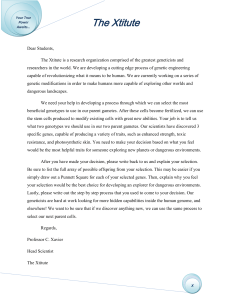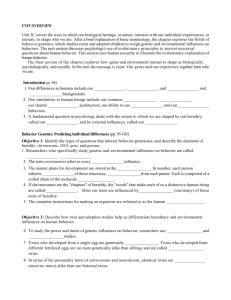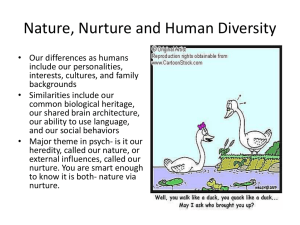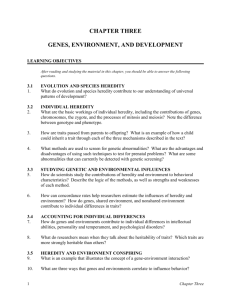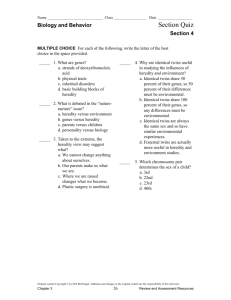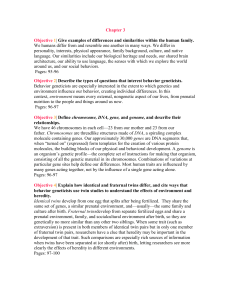Chapter 3 Review Notes
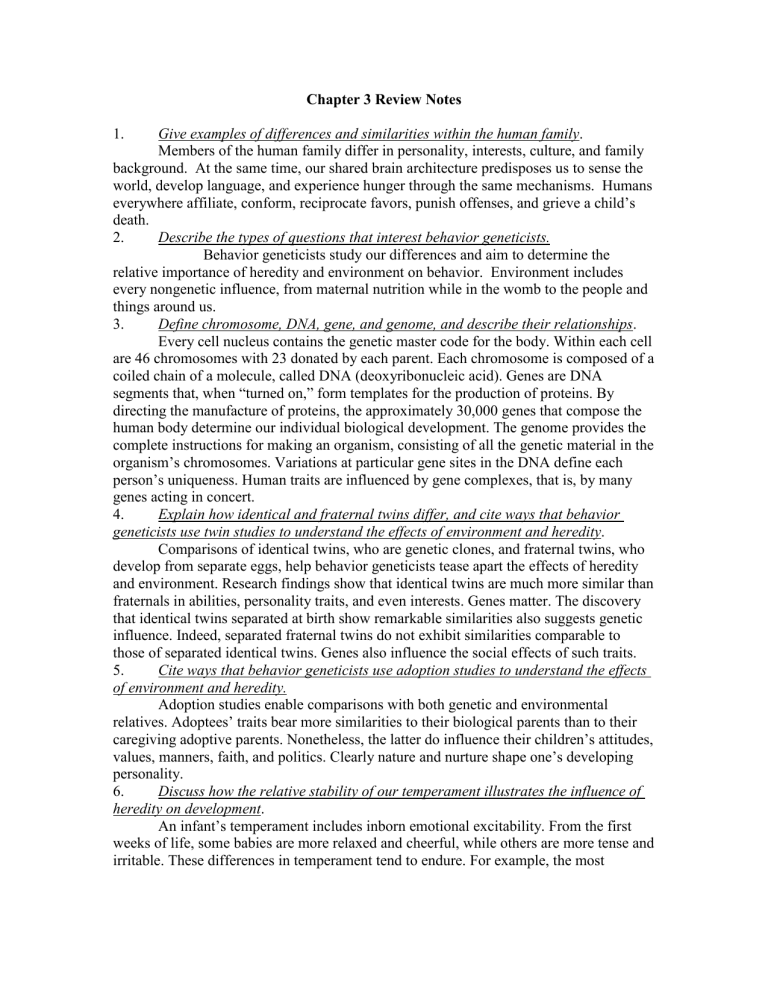
1.
Chapter 3 Review Notes
Give examples of differences and similarities within the human family .
Members of the human family differ in personality, interests, culture, and family background. At the same time, our shared brain architecture predisposes us to sense the world, develop language, and experience hunger through the same mechanisms. Humans everywhere affiliate, conform, reciprocate favors, punish offenses, and grieve a child’s death.
2. Describe the types of questions that interest behavior geneticists.
Behavior geneticists study our differences and aim to determine the relative importance of heredity and environment on behavior. Environment includes every nongenetic influence, from maternal nutrition while in the womb to the people and things around us.
3. Define chromosome, DNA, gene, and genome, and describe their relationships .
Every cell nucleus contains the genetic master code for the body. Within each cell are 46 chromosomes with 23 donated by each parent. Each chromosome is composed of a coiled chain of a molecule, called DNA (deoxyribonucleic acid). Genes are DNA segments that, when “turned on,” form templates for the production of proteins. By directing the manufacture of proteins, the approximately 30,000 genes that compose the human body determine our individual biological development. The genome provides the complete instructions for making an organism, consisting of all the genetic material in the organism’s chromosomes. Variations at particular gene sites in the DNA define each person’s uniqueness. Human traits are influenced by gene complexes, that is, by many genes acting in concert.
4. Explain how identical and fraternal twins differ, and cite ways that behavior geneticists use twin studies to understand the effects of environment and heredity .
Comparisons of identical twins, who are genetic clones, and fraternal twins, who develop from separate eggs, help behavior geneticists tease apart the effects of heredity and environment. Research findings show that identical twins are much more similar than fraternals in abilities, personality traits, and even interests. Genes matter. The discovery that identical twins separated at birth show remarkable similarities also suggests genetic influence. Indeed, separated fraternal twins do not exhibit similarities comparable to those of separated identical twins. Genes also influence the social effects of such traits.
5. Cite ways that behavior geneticists use adoption studies to understand the effects of environment and heredity.
Adoption studies enable comparisons with both genetic and environmental relatives. Adoptees’ traits bear more similarities to their biological parents than to their caregiving adoptive parents. Nonetheless, the latter do influence their children’s attitudes, values, manners, faith, and politics. Clearly nature and nurture shape one’s developing personality.
6. Discuss how the relative stability of our temperament illustrates the influence of heredity on development .
An infant’s temperament includes inborn emotional excitability. From the first weeks of life, some babies are more relaxed and cheerful, while others are more tense and irritable. These differences in temperament tend to endure. For example, the most
emotionally intense preschoolers tend to be relatively intense as young adults. Compared with fraternal twins, identical twins have more similar temperaments.
7. Discuss heritability’s application to individuals and groups, and explain what we mean when we say genes are self-regulating .
Using twin and adoption methods, behavior geneticists can mathematically estimate the heritability of any trait—the extent to which variation among individuals is due to their differing genes. If the heritability of intelligence is 50 percent, this does not mean that one’s intelligence is 50 percent genetic. Instead it means that we can attribute to genetic influence 50 percent of the observed variation among people. The heritability of a specific trait may vary, depending on the range of populations and environments studied. As environments become more similar, heredity as a source of differences becomes more important. Our genes affect how our environment reacts to and influences us. Nature enables nurture.
Heritable individual differences need not imply heritable group differences. Genes and environment work together. Because of human adaptability, most psychologically interesting traits are expressed in particular environments. In other words, genes are selfregulating; they can react differently in different environments.
8. Give an example of a genetically influenced trait that can evoke responses in others, and give another example of an environment that can trigger gene activity.
We are all the products of interactions between our genetic predispositions and our surrounding environments. A baby who is genetically predisposed to be social and easygoing may, in contrast to one who is less so, attract more affectionate and stimulating care and thus develop into a warmer and more outgoing person. Similarly, a stressful environment can trigger genes that affect the production of neurotransmitters that underlie depression.
9. Identify the potential promise and perils of molecular genetics research .
In dozens of labs worldwide, molecular geneticists are teaming with psychologists in search of genes that put people at risk for genetically influenced disorders. Potentially, steps may be taken to prevent problems before they happen. With this benefit, however, also come risks of labeling people in ways that may lead to discrimination. Prenatal screening also poses hopeful possibilities and difficult problems as parents become able to select the traits. In countries where boys are highly valued, testing for an offspring’s sex has enabled selective abortions. Millions of parents will select for health—and perhaps for brains, beauty, and athleticism. However, by “selecting” out certain traits, we may deprive ourselves of future Handels, van Goghs, Lincolns, and Dickinsons, all troubled people.
10. Describe the area of psychology that interests evolutionary psychologists .
Evolutionary psychologists focus on what makes us so much alike as humans.
They study how natural selection has shaped our universal behavioral tendencies.
11. State the principle of natural selection, and point out some possible effects of natural selection in the development of human characteristics.
Natural selection is the principle that, among the range of inherited trait variations, those that lead to increased reproduction and survival will most likely be passed on to succeeding generations. Nature selects beneficial variations from among the mutations (random errors in gene replication) and the new gene combinations produced at each human conception. During human ancestry, genes that enable today’s capacity to
learn and to adapt had survival value. Similarly, we love the taste of fats and sweets, which once were hard to come by but which prepared our ancestors to survive famines.
This particular natural disposition is mismatched with today’s junk-food environment.
12. Identify some gender differences in sexuality.
Gender refers to the biologically and socially influenced characteristics by which people define male and female. One of the largest reported gender differences is women’s greater disapproval of and lesser willingness to engage in casual, uncommitted sex. In comparison to women, men think more about sex, masturbate more often, are more likely to initiate sex, and make more sacrifices to gain sex. Men also have a lower threshold for perceiving warm responses as a sexual come-on. The unfortunate response can range from sexual harassment to date rape.
13. Describe evolutionary explanations for gender differences in sexuality .
Evolutionary psychologists apply the principle of natural selection to explain women’s more relational and men’s more recreational approaches to sex. Compared with eggs, sperm are cheap. While a woman cares for a single infant, a man can spread his genes by impregnating other females. Women most often send their genes into the future by pairing wisely, men by pairing widely. Women increase their own and children’s chances of survival by searching for mates with economic resources and social status.
Being attracted to healthy, fertile-appearing partners increases men’s chances of spreading their genes widely.
14. Summarize the criticisms of evolutionary explanations of human behaviors, and describe the evolutionary psychologists’ responses to those criticisms .
Critics argue that evolutionary psychologists start with an effect (e.g., gender sexuality difference) and work backward to propose an explanation. In addition, much of who we are is not hardwired. Cultural expectations shape the genders. Still others suggest that evolutionary explanations may undercut moral responsibility for sexual behavior. In response, evolutionary psychologists point to the explanatory power of their theoretical principles, especially those offering testable predictions. They also note that understanding our propensities may help us to overcome them.
15. Describe some of the conditions that can affect development before birth .
In the womb, embryos receive different nutrition and varying levels of exposure to toxic agents. Even identical twins may have separate placentas in which one may have a more advantageous placement that provides better nourishment and a better placement barrier against viruses.
16. Describe how experience can modify the brain.
Normal stimulation during the early years is critical for optimal brain development. After brain maturation provides us with an abundance of neural connections, experience preserves our activated connections and unused connections degenerate (a process called pruning). Experiences modify a rat’s neural tissue at the very place in the brain that processes the experience. Throughout life, sights, smells, and touches strengthen some neural pathways while others weaken from disuse.
17. Explain why we should be careful in attributing children’s successes and failures to their parents’ influence.
Parental influence is clearest at the extremes, for example, in the abused who become abusive and in the loved but firmly handled children who become self-confident and socially competent. Parental influence is also reflected in children’s political
attitudes, religious beliefs, and personal manners. However, environmental influences typically account for less than 10 percent of children’s personality differences. This finding suggests that parents be given less credit for their children’s successes as well as less blame for their failures.
18. Evaluate the importance of peer influence on development.
Parental and peer influences are complementary. Parents are more influential when it comes to education, discipline, responsibility, orderliness, charitableness, and ways of interacting with authority figures. Peers are more important for learning cooperation, for finding the road to popularity, and for inventing styles of interaction among people of the same age. In part, similarity to peers may result from a selection effect. Parents choose the neighborhoods and schools that supply the peers.
19. Discuss the survival benefits of culture .
A culture is the enduring behaviors, ideas, attitudes, and traditions shared by a large group of people and transmitted from one generation to the next. Culture supports survival with social and economic systems that enable us to eat fruit in the winter, surf the Internet, and accumulate information. Our capacity for language enables us to preserve innovations and pass them on to the next generation. Culture’s accumulated knowledge has significantly increased life expectancy over the last century.
20. Describe some ways that cultures differ .
All cultural groups evolve their own norms, rules that govern their members’ behaviors. Although these rules sometimes seem oppressive, they also grease the social machinery. Cultures vary in their requirements for personal space, their expressiveness, and their pace of life. When cultures collide, their differing norms may make us uncomfortable.
21. Explain why changes in the human gene pool cannot account for culture change over time.
Cultures do change over time. In addition to changes that come with technological advance, cultures change in attitudes, values, and behavior. For example, with greater economic independence, today’s women are less likely to endure abusive relationships out of economic need. Many minority groups enjoy expanded human rights. Not all culture change is positive. For example, within the last few decades, the United States has seen sharply increased rates of divorce, teen suicide, depression, and juvenile violent crime. Changes in the human gene pool evolve far too slowly to account for these rapid cultural changes.
22. Identify some ways a primarily individualist culture differs from a primarily collectivist culture, and compare their effects on personal identity.
Individualist cultures value personal achievement and fulfillment as well as individual rights and liberties. Relationships are often temporary and casual.
Confrontation is acceptable and morality is self-defined. Individualists tend to define identity in terms of personal traits, and one’s life task is to discover and express one’s uniqueness. Collectivist cultures value group goals and solidarity. Relationships tend to be close and enduring. Maintaining social harmony is important and morality is dutybased. Collectivists derive their identity from belonging, and one’s life task is to maintain social connections, fit in, and perform one’s role.
23. Describe some ways that child-rearing differs in individualist and collectivist cultures.
While people in individualist cultures encourage independence in their children, those in collectivist cultures focus on emotional closeness. Children in collectivist cultures grow up with a stronger sense of family self. The diversity of child-rearing practices makes it clear that children can thrive under various systems.
24. Describe some ways that humans are similar, despite their cultural differences .
Cross-cultural research helps us appreciate both our cultural diversity and our human kinship. We share the same genetic profile and life cycle. As members of one species, we seem subject to the same psychological forces. Our different languages demonstrate universal principles of grammar. Our varied tastes reflect common principles of hunger. Our different social behaviors show the same need to belong. Norms are rules that govern their members’ behaviors.
25. Identify some biological and psychological differences between males and females.
Males and females are similar in genetic makeup as well as levels of intelligence, vocabulary, self-esteem, and happiness. Males and females differ in body fat, muscle, height, and life expectancy. Females are more vulnerable to depression, anxiety, and eating disorders. In contrast, males are more likely to commit suicide and suffer alcoholism. They are also much more likely to be diagnosed with autism, color-blindness, hyperactivity as children, and antisocial personalities as adults.
26. Summarize the gender gap in aggression.
In surveys, men admit to more aggression than women, and experiments confirm that men tend to behave more aggressively such as by delivering what they believe are painful shocks. The same difference is reflected in violent crime rates. The gender gap in physical aggression appears in many cultures and across various ages.
27. Describe some gender differences in social power.
Throughout the world, men are perceived as more dominant, forceful, and independent, while women are viewed as more deferential, nurturant, and affiliative. In groups, leadership tends to go to males. In everyday behavior men are more likely to talk assertively, to interrupt, to initiate touching, to smile less, and to stare.
28. Discuss gender differences in connectedness, or the ability to “tend and befriend.”
In comparison to men, women are more concerned with making social connections. This gender difference surfaces early, in children’s play. As teens, girls spend more time with friends and less time alone. In coping with stress, women more often turn to others for support. Women emphasize caring, often assuming responsibility for the very young and very old. Both men and women indicate that their friendships with women tend to be more intimate, enjoyable, and nurturing.
29. Explain how biological sex is determined, and describe the role of sex hormones in biological development and gender differences.
Biological sex is determined by the twenty-third pair of chromosomes, the sex chromosomes. The member of the pair inherited from the mother is an X chromosome.
The X (female) or Y (male) chromosome that comes from the father determines the child’s sex. The Y chromosome triggers the production of the principal male sex hormone, testosterone, which in turn triggers the development of external male sex organs. A female embryo exposed to excess testosterone is born with masculineappearing genitals. Until puberty, such females tend to act in more aggressive,
“tomboyish” ways than is typical of most girls. The fact that people may treat such girls more like boys illustrates how early exposure to sex hormones affects us both directly (in our biological appearance) and indirectly—by influencing social experiences that shape us. Thus, nature and nurture work together.
Preliminary research confirms male-female differences in brain areas with abundant sex hormone receptors during development. For example, during adulthood the part of the frontal lobes involved in verbal fluency is thicker in women and part of the parietal lobes involved in space perception is thicker in men.
30. Discuss the relative importance of environment on the development of gender roles, and describe two theories of gender-typing.
Although biology influences our gender, gender is also socially constructed.
Culture shapes our roles: a role is a cluster of prescribed actions. For example, gender roles—our expectations about the way men and women behave—vary across cultures and time. For instance, in nomadic societies of food-gathering people, there is little division of labor by sex. Thus, boys and girls receive much the same upbringing. In agricultural societies, women stay close to home while men often roam more freely. Such societies typically socialize children into distinct gender roles. Even among industrialized countries, gender roles vary greatly, for example, in the expectation that life will be more satisfying when both spouses work and share childcare.
Society assigns each of us to the social category of male and female. The result is our gender identity, our sense of being male or female. To varying degrees, we also become gender-typed, acquiring a traditional male or female role. Social learning theory assumes that children learn gender-linked behaviors by observing and imitating significant others and by being rewarded and punished. Gender schema theory assumes that children learn from their cultures a concept of what it means to be male or female and adjust their behavior accordingly.
31. Describe the biopsychosocial approach to development .
Nature and nurture jointly form us. That is, we are products of natural selection and heredity as well as cultural, family, peer, and media influences. But we are also open systems—that is, creators as well as creatures of our worlds. We respond to the world’s response to us. Our efforts to affiliate with others, cope with challenges, and build our own personal strengths and values demonstrate how the stream of causation runs through our present choices.

